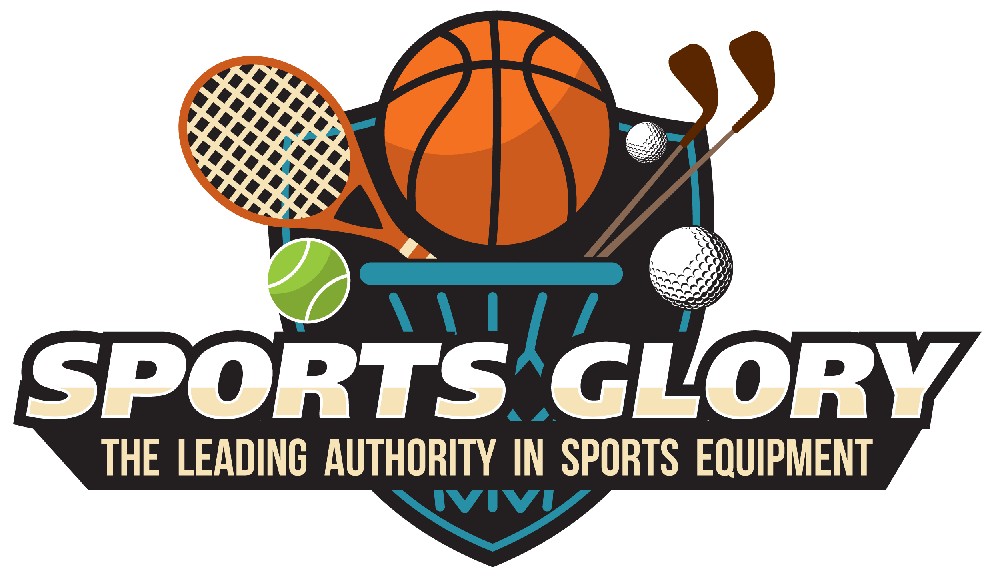Most of us take our feet (and the rest of our bodies) for granted. Nobody bothers to think about something as dull as insoles when they’re running around the soccer pitch– until something goes wrong.
Maybe you’re struggling with discomfort in your foot when you play – or even in your back, knee, or shin. Or perhaps you’re part of the admirable minority who simply want to go the extra mile to look after their bodies.
Putting some time and thought into choosing the perfect insoles for soccer cleats will allow you to do what you love without having to worry about the throbbing pain in your feet. You might be surprised at how much it improves your performance.
Contents
- Features to Look for in Insoles for Soccer Cleats
- Top 10 Best Insoles for Soccer Cleats 2024
- 1. Best Overall Soccer Insoles: Spenco Polysorb Insoles
- 2. Best Premium Soccer Insoles: Superfeet Black Insoles
- 3. Best Budget Soccer Insoles: Dr. Scholl’s Sport Insoles
- 4. Best Soccer Insoles for High Arches: EASYFEET Orthotic Arch Support Insoles
- 5. Best Soccer Insoles for Low Arches: Sof Sole FIT Support Insoles
- 6. Best Soccer Insoles for All Arch Types: Powerstep Orthotic Shoe Insoles
- 7. Best Anti-Slip Soccer Insoles: Currex CLEATPRO
- 8. Most Comfortable Soccer Insoles: VoMii PU Memory Foam Insoles
- 9. Best Lightweight Soccer Insoles: Sof Sole Gel Insoles
- 10. Thinnest Soccer Insoles: Physix Gear Orthotic Inserts
- Choosing the Perfect Insoles
- Soccer Insole FAQs
- Bottom Line
Features to Look for in Insoles for Soccer Cleats
If you’re new to the world of soccer cleat insoles, you might wonder how much variation there can be between different types. Oh, sweet summer child. Choosing the wrong pair could make your feet conditions worse instead of better, so do your research.
Material
Let’s start with the simple stuff – we all know soccer cleat insoles have to be made of something, right? When looking at the material used, there are three main elements to consider: how breathable it is, how sanitary it is, and how much comfort it provides.
For breathability, look for little holes that let the air out, or a velvet-type fabric. To prevent your shoes from fostering any more bacteria than they already do, antimicrobial material helps.
Many insoles contain foam to provide maximum comfort and protection. To find out more about the best materials for your feet, check out our more detailed breakdown.
What about comfort? That leads nicely to our next point.
Design
If you’re looking for soccer cleat insoles, there’s a high chance you’ve already experienced some discomfort in your feet. Time to turn things around!
One of the most effective support measures insoles can have is gel pads, which give your feet a massaging effect while absorbing impact. The heel and forefoot area are the most important parts to protect.
Also, look at how thick and elevated an insole is – those who have severe feet conditions or pain typically require more support, although you need to think about whether you can fit a thick insole in your shoe.
However, not all feet need the same type of support.
Arch Support
Now, things are about to get technical. Have you ever had a friend who always harps on about having high arches or low arches? Or maybe that friend is you. If so, good on you, because arches are important.
Before you go ahead and choose a pair of insoles, it’s essential to know whether you have low, neutral, or high arches. This affects both the type and level of support you need, so give yourself a quick diagnosis.
Anti-Slip
As a soccer player, you should know better than anyone how important stability is. Although soccer cleats themselves tend to have anti-slip design features, many insoles also contain them.
Look out for insoles that have a “cradle” for the heel, which provides balance, or an extra coating to provide grip, like the Currex CLEATPRO insoles.
Size
Most insoles come in specific sizes for your feet, but that’s no guarantee that they’ll be a perfect fit. Some soccer boots are narrower than others – if you own a particularly thin pair, you need to check that your insoles aren’t too large for them. Equally, it can ruin performance if your insole slips around in your shoe.
“Low-profile” insoles are the thinnest and easiest to fit in, while insoles with lots of cushioning could cause issues.
Trim-to-fit
Luckily, lots of insoles are trim-to-fit. Even if you can’t get the perfect fit first time around, you can cut them until they fit your boots just right. A good example are the Superfeet black insoles. We’ll let you know which insoles have guidelines for trimming, but even those that don’t can usually be cut down a bit—as long as you’re careful.
Top 10 Best Insoles for Soccer Cleats 2024
Know what type of arches you have, how much space there is in your soccer cleats, and what level of support you need? It’s time to start your search for the ultimate insoles.
1. Best Overall Soccer Insoles: Spenco Polysorb Insoles
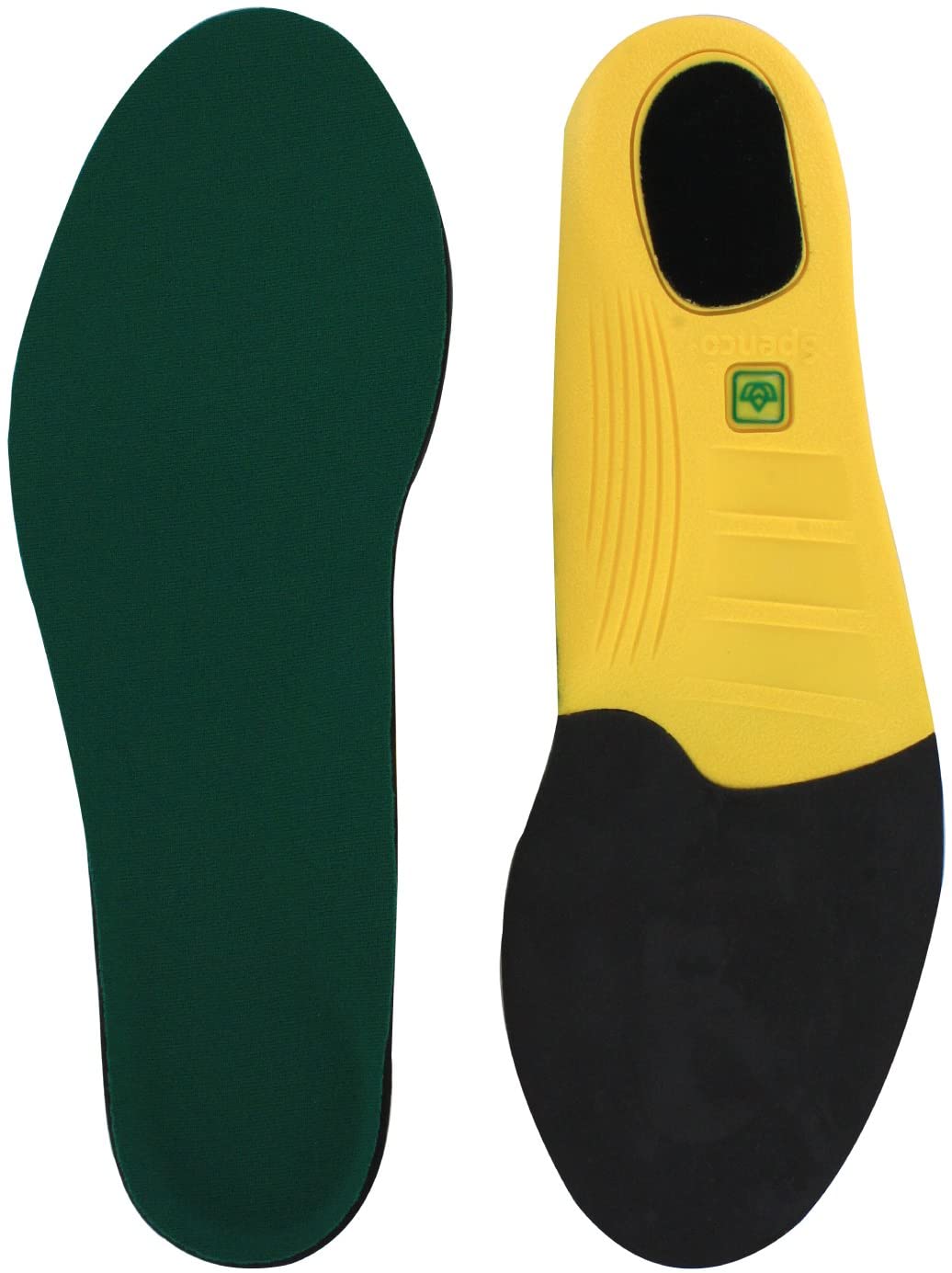
Editor’s Rating:
Quick Facts:
- Best for neutral arches
- Material: Antimicrobial nylon and PolySorb foam
- Trim-to-fit: No
If you don’t suffer from high/low arches or a particular foot condition and simply want high-quality support for your feet, these insoles are a great option. Spenco is a leading manufacturer of both footwear and support accessories and made its Polysorb Insoles specifically for sports like soccer.
The insoles are ideally suited to anyone with neutral arches, but may also work for people with only slightly high or low arches. If you do have particularly high arches, however, you might prefer the EASYFEET Orthotic Arch Support Insoles, while those with very low arches should consider the Sof Sole FIT Support Insoles.
Insole Design
There’s a layer of of polysorb polyurethane foam to give the arch and heel of your foot extra support, including an extra cushioned area where the heel hits the insole. This is a lovely, lightweight type of foam.
The forefoot area features a “crash pad” of cushioning. Basically, wherever you could possibly need some support, you’ll find it.
Contracting additional problems like blisters and fungal infections can be almost as deadly as painful foot conditions when you’re a soccer player, but Spenco has also solved that problem. It uses silpure, a stretchy microbial and lightweight microbial fabric to keep your feet cool and aid breathability, as well as fighting off nasty odor.
Not to say that your feet smell bad, but let’s face it, they probably do. You can read more about silpure and polysorb in our fabrics comparison.
- Lots of cushioning
- Lightweight and breathable
- Designed specifically for high impact sports
- Not enough support for very high or low arches
2. Best Premium Soccer Insoles: Superfeet Black Insoles
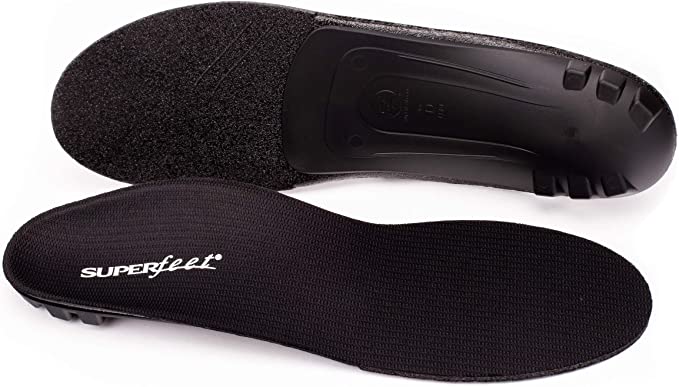
Editor’s Rating:
Quick Facts:
- Best for neutral and flat arches
- Material: Odor-controlling high-density foam
- Trim-to-fit: Yes
Superfeet is an established brand in the world of insoles, and these premium insoles have a bundle of features that justify the high price.
Also, Superfeet claims the build is durable enough for the insoles to last for one year, or 500 miles – this guarantees you’ll get your money’s worth.
Insole Design
Made of organic odor-controlling material and a mesh texture, they’re breathable and sanitary. To support the foot, there’s a layer of high-density foam, sculpted upwards at the back of the foot to provide comfort and reduce irritation.
For added stability, there are claws on the bottom plastic layer to keep the heel in place and stop it from rolling. There’s also a heel cup on the inner side of the insole to provide extra comfort to this sensitive area.
They’re both low-profile (thin) and-low volume, meaning they won’t take up much room in your boots. Perfect for anyone who just needs light support, but not so much for those with high or low arches.
However, bear in mind that they have a fairly wide midfoot part; if you have very tight soccer cleats (like Mercurial or Puma), they might not fit in properly—although they are trim to fit, so you’ll have a bit of wiggle room.
- Good for various arches
- Made of organic and natural coating
- Last for a year of wear
- Won’t fit into tighter boots
3. Best Budget Soccer Insoles: Dr. Scholl’s Sport Insoles
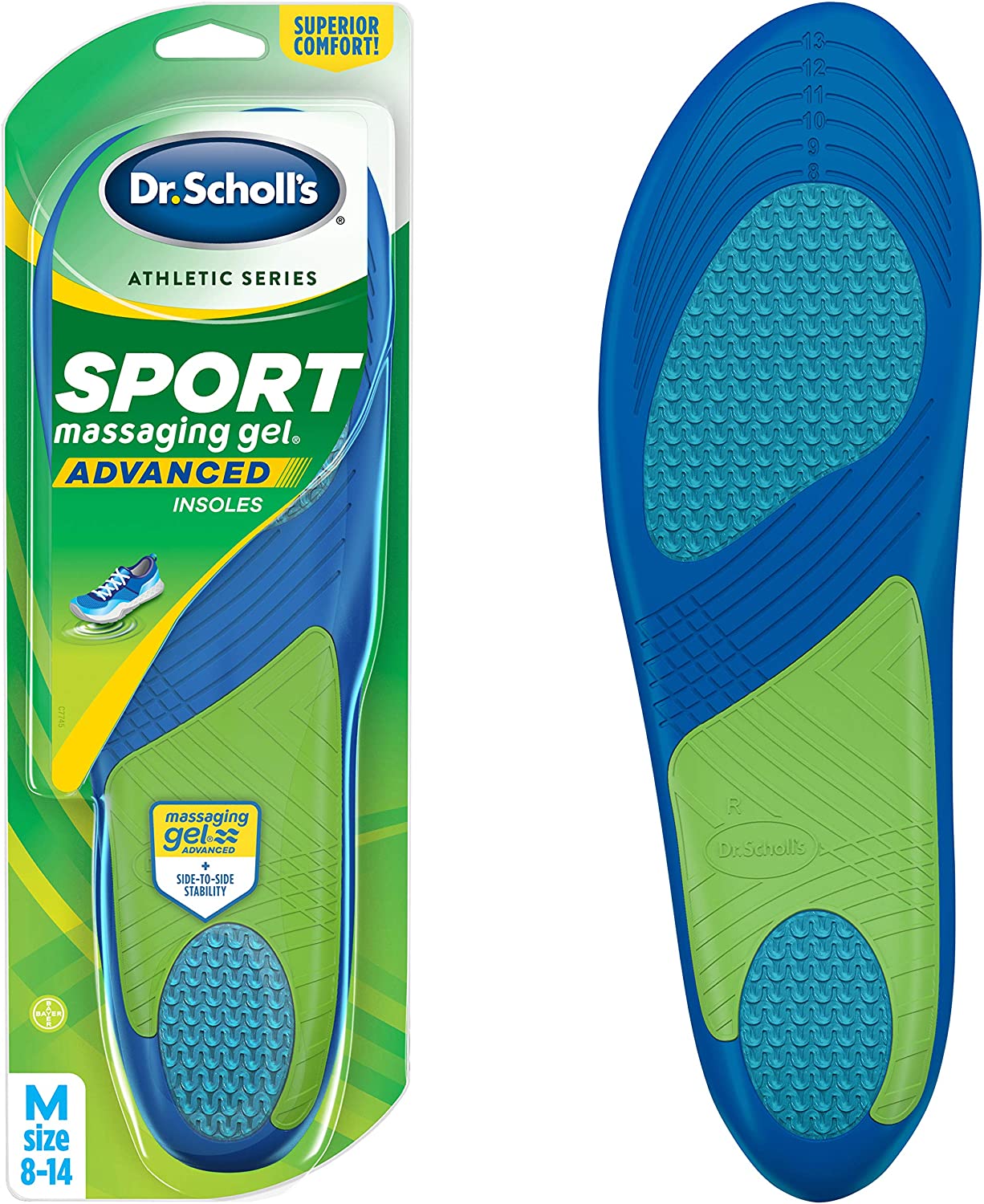
Editor’s Rating:
Quick Facts:
- Best for neutral and high arches
- Material: Gel
- Trim-to-fit: Yes
Making a budget choice doesn’t have to mean compromising on quality. For less than half the price of other options, Dr. Scholl’s provides a solid insole. Specializing in orthotics and inserts, it’s a brand you can trust.
These sports insoles aren’t built to suit a single type of foot or arch, which means they’re ideal for anyone with neutral arches or a slightly high arch. However, they’re less likely to suit anyone with flatter feet.
You can trim the insoles to ensure they match the fit of your cleats perfectly. They’re fairly lightweight and thin already – great for narrow boots but not for people who need extra support.
Insole Design
There are two notable features of the insole design: the massaging gel and the flexible arch shell.
The gel pad is found at the forefoot and near the heel of the insole, providing cushioning and shock absorption to keep your feet comfortable. Meanwhile, the arch shell is there to provide stability as you move about the pitch. This won’t just benefit your feet but also your legs, knees, and back.
However, the arch support isn’t as substantial as other options.
- Massaging gel provides extra support and comfort
- Arch shell for balance
- Good for narrow soccer cleats
- The support could be more comprehensive
4. Best Soccer Insoles for High Arches: EASYFEET Orthotic Arch Support Insoles
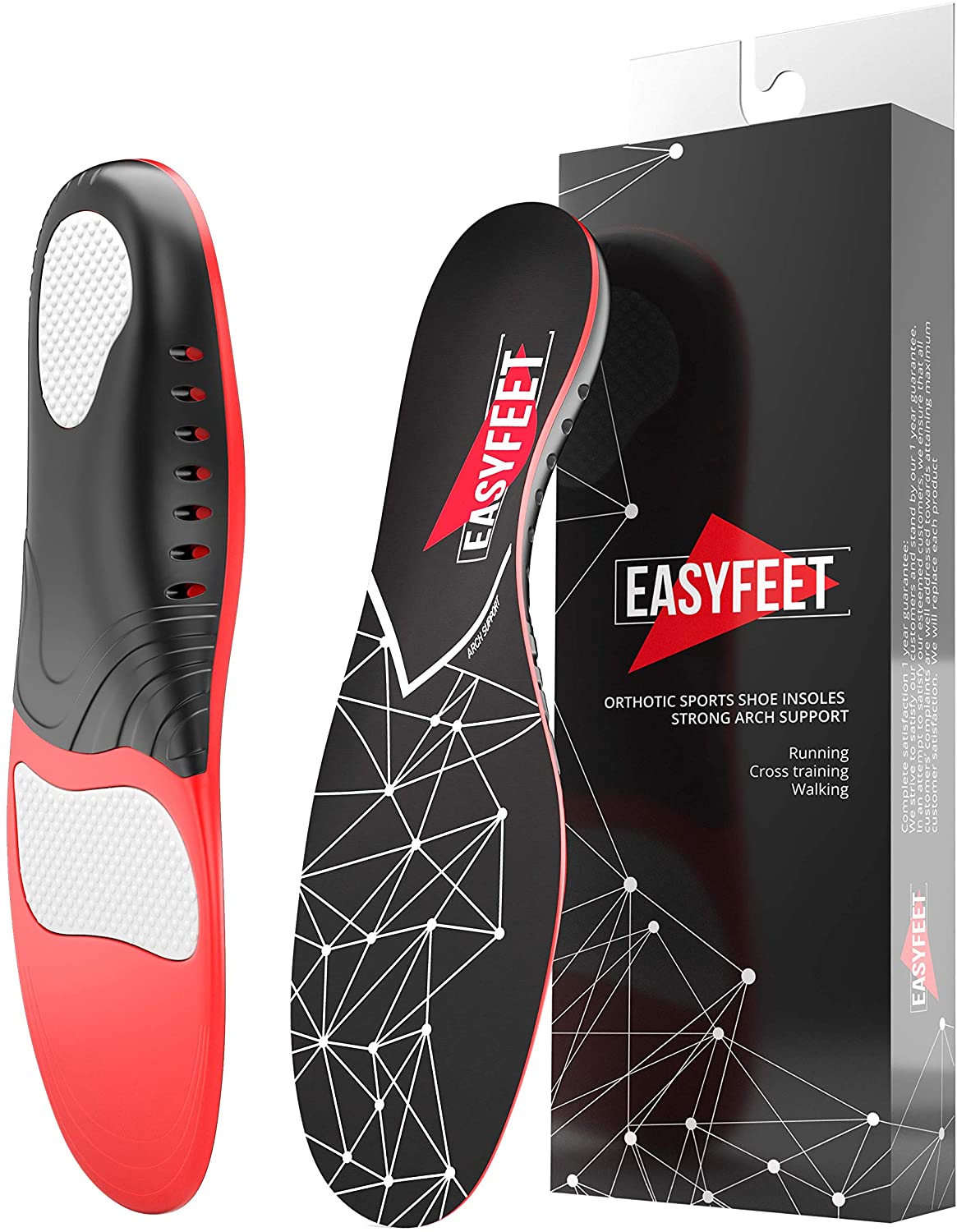
Editor’s Rating:
Quick Facts:
- Best for high arches
- Material: Breathable cover, firm TPU/PU foam
- Trim-to-fit: Yes
If you have high arches, nothing is more important than giving your feet the support they need after absorbing so much impact from playing soccer. The EASYFEET insoles offer all that and more.
The insoles are unisex, but you can choose the size (between XS and XL) that fits you best. If this still isn’t the right fit, you can trim them until they’re the perfect size for your cleats, which anyone with super narrow soccer boots will be relieved to know.
EASYFEET promises pain relief in one week, and with such a supportive design, that claim seems believable. As a podiatrist recommended product, these insoles take looking after your feet seriously. They support the limbs and spine and are perfect for people with feet conditions like corns and heel spur.
Insole Design
The breathable cover with a velvety texture stops heat and friction from affecting your feet, and it also fights odor. Meanwhile, the insoles have a large middle section for cushioning and shock absorption, made of a mix of firmer TPU and softer PU memory foam.
These are some of the higher quality materials available and provide strong support for your arches.
The forefoot section of the insole contains gel and air capsules, and the heel section has a cradle to ensure the foot bone remains vertical and balanced. Of course, the primary focus of the insole is supporting the arch.
However, the amount of padding and cushioning could be excessive for anyone with neutral arches or narrower soccer cleats. Something like the Physix Gear Orthotic Inserts should fit even the smallest cleats, but it’s not quite as supportive for those with very high arches.
- Provides lots of support
- High-quality materials
- Great for anyone with feet conditions or high arches
- Could be too thick for some cleats
- Not suitable for those with lower arches
5. Best Soccer Insoles for Low Arches: Sof Sole FIT Support Insoles
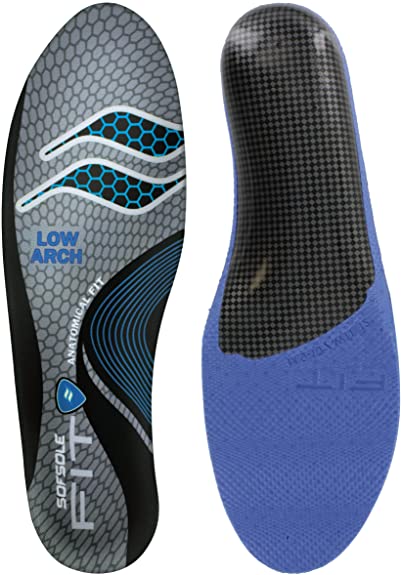
Editor’s Rating:
Quick Facts:
- Best for low arches
- Material: Firm foam surface with nylon sole
- Trim-to-fit: No
If you have low arches, getting insoles that give your foot the shape they need is a must. We rely on our arches to protect the rest of the foot from impact, so without them, we risk subjecting ourselves to unnecessary discomfort.
Just in case you like the idea of these insoles but don’t have low arches, they’re also available with a slightly different structure for high and neutral arches.
Insole Design
The insoles feature a 2.8cm arch height in the middle to imitate the shape of a natural arch. To provide even more support, there’s a firm and dense foam surface that molds to your feet.
Your heel rests on a nylon plate and a deep heel cup for stability, and there are also air capsules in the heels for cushioning. These take the impact your shoes absorb as you run around the pitch and convert it into kinetic energy.
These insoles are made of nylon, a synthetic material that isn’t known for its quality and breathability compared to other fabrics. However, there’s also moisture-wicking technology to keep the feet dry, cool, and odorless.
- 2.8cm elevation is perfect for low arches
- Keep feet dry with moisture-wicking technology
- Provide stability
- Made of nylon, which is less breathable
6. Best Soccer Insoles for All Arch Types: Powerstep Orthotic Shoe Insoles
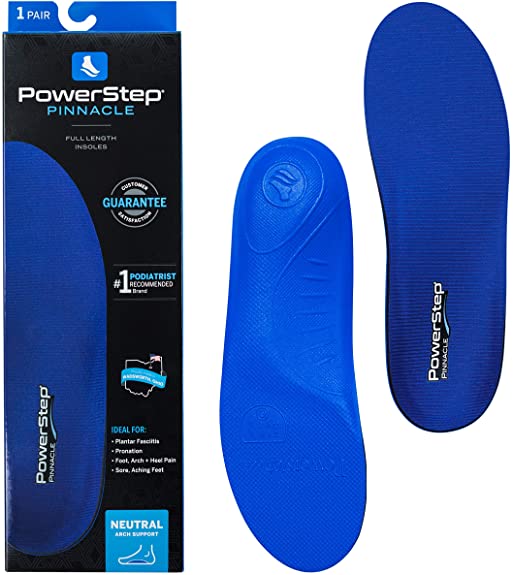
Editor’s Rating:
Quick Facts:
- Best for all arches
- Material: Semi-rigid EVA foam
- Trim-to-fit: Yes
When most insoles claim to be suitable for all arch types, what they really mean is that they’re best for neutral arches – but these soccer cleat insoles genuinely manage to work well with feet of all kinds. A modern-day miracle!
They’re particularly well-suited to anyone with conditions like plantar fasciitis. Oh, and they’re made in the USA, which is a marker of higher quality.
Insole Design
There’s a two-layer design. The antimicrobial fabric used on the top side of the insole keeps your feet sanitary, while the second layer has an EVA foam base. EVA is firmer than other foam types, but ideal for athletic activities.
Also, the back of the insole features a premium heel cradle for added stability.
The support provided is semi-rigid – it’s definitely there, but not as excessive as some other options. That’s the secret behind how Powerstep caters to so many different kinds of feet. Of course, everyone’s feet are different, and some people might prefer more support.
- Work with all types of arches
- Helps with feet conditions
- Made in the USA
- Might not provide enough support for some feet
7. Best Anti-Slip Soccer Insoles: Currex CLEATPRO
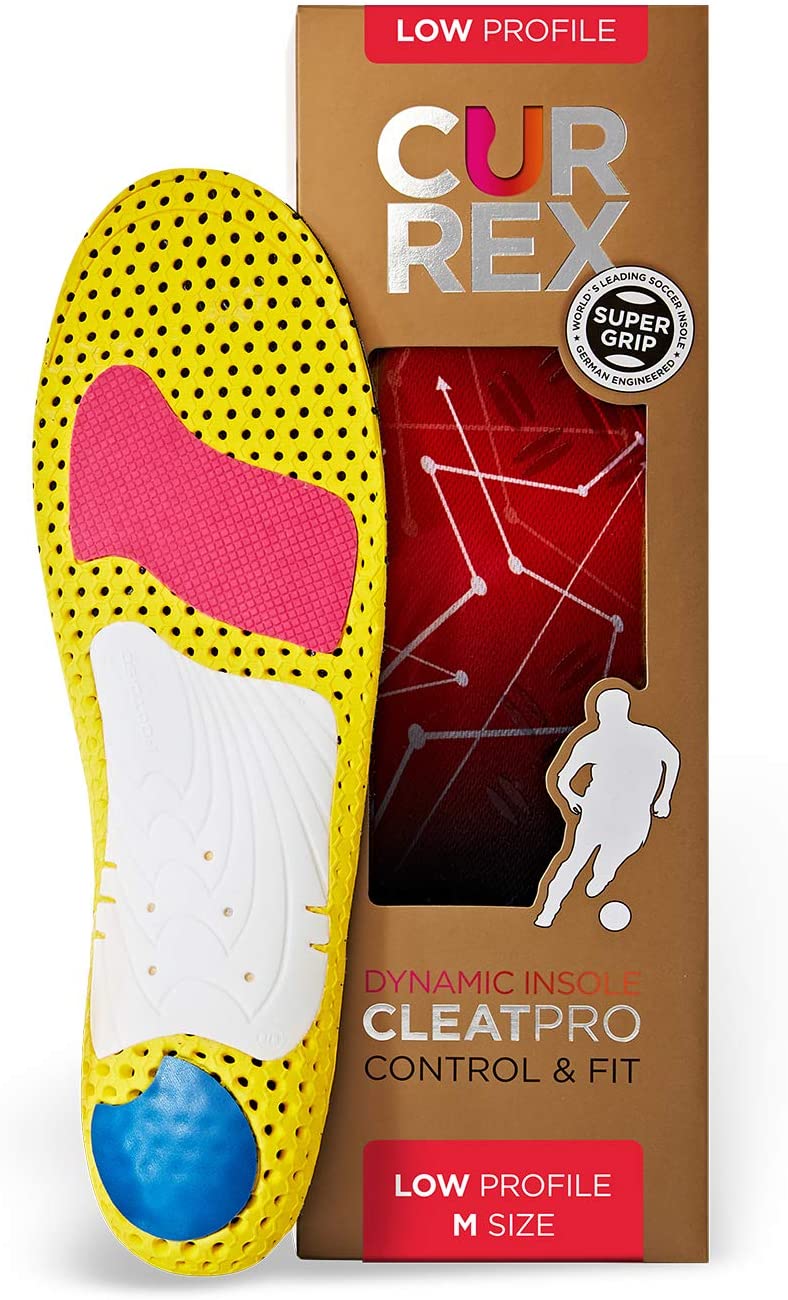
Editor’s Rating:
Quick Facts:
- Best for all arches
- Material: Foam with bamboo
- Trim-to-fit: No
While most companies offer generic “sports” or “exercise” insoles, Currex has created different insoles for different sports. There are other versions available for running and biking, for instance.
To customize the insoles further, you can choose between low, medium, or high arches. Not sure which you have? Check our section about figuring out your arch type.
A blind test done at a German sports university found that Currex insoles performed the best for pressure relief and comfort. The national German soccer team also uses the brand, so they must be doing something right.
Insole Design
Currex has gone above and beyond in its design, justifying the high price tag it asks for. The exact design depends on whether you opt for the low, medium, or high arch version, but there are a few consistent features.
NEO Touch SuperGrip anti-slip technology might sound like a mouthful, but it gives you the balance you need when sprinting and around the pitch and rapidly changing direction.
The second layer is made from bamboo, a refreshingly natural choice to promote breathability.
Finally, there are shock absorbers placed in the rear and forefoot regions, and a guidance system in the middle of the insole to give the wearer balance.
The insole design promotes what Currex calls a “dynamic cycle of benefits” – when the foot makes contact with the insole, it activates thousands of foot nerves, which optimizes the fit of the shoe and makes it even better at stimulating the foot nerves. As the insole molds to your feet, the design becomes even more beneficial over time.
However, they’re very thin, which doesn’t suit everyone.
- Different types available for different arch types
- Special anti-slip technology
- Adapts to your feet
- Expensive
- Could be too thin for some people
8. Most Comfortable Soccer Insoles: VoMii PU Memory Foam Insoles
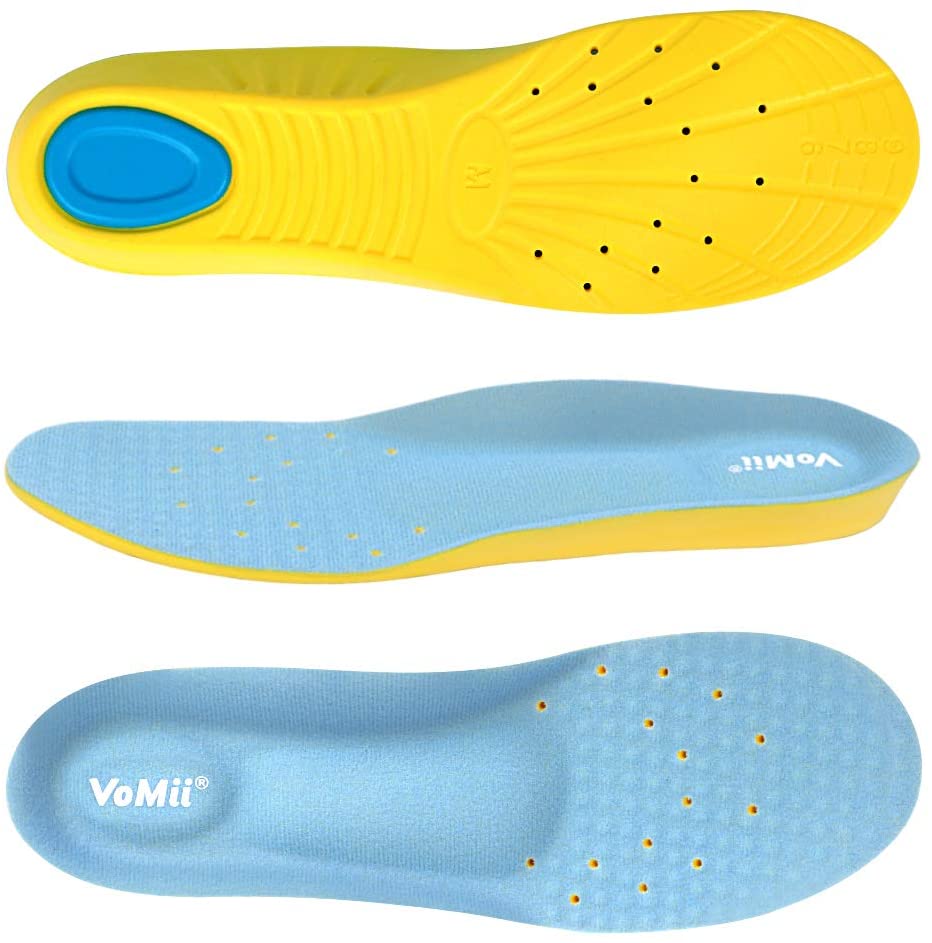
Editor’s Rating:
Quick Facts:
- Best for neutral and high arches
- Material: Memory foam, gel, and velvet
- Trim-to-fit: Yes
Made up of a winning combination of bouncy memory foam, gel pads, and medical-grade velvet, the VoMii insoles are comfortable enough to wear all day.
The foam absorbs shocks and makes sure your foot remains comfortable, while the velvet layer contains holes to let moisture escape and allow the feet to breathe. However, the PU foam used isn’t as effective as a more expensive material like TPU or EVA.
It’s also worth pointing out that VoMii isn’t an insole, sports, or even shoes specialist. This might not be a big deal to everyone, but alongside the cheaper material and price, it’s a sign of lower quality.
Insole Design
The insoles are ideal for high or neutral arches, with a 2.3cm raise to absorb the shocks from high impact sports. They can even help with conditions like plantar fasciitis thanks to the level of support and comfort.
There’s a deep heel cradle to help soccer players retain their balance and support the foot in one of its most vulnerable parts.
In addition to the features for breathability and comfort, the insoles are also non-slip, although the technology isn’t as sophisticated as what’s used in the Currex CLEATPRO insoles.
- Very affordable
- Good support for high arches
- Perforations for breathability
- Lower quality than other options
- Less suited to neutral or low arches
9. Best Lightweight Soccer Insoles: Sof Sole Gel Insoles
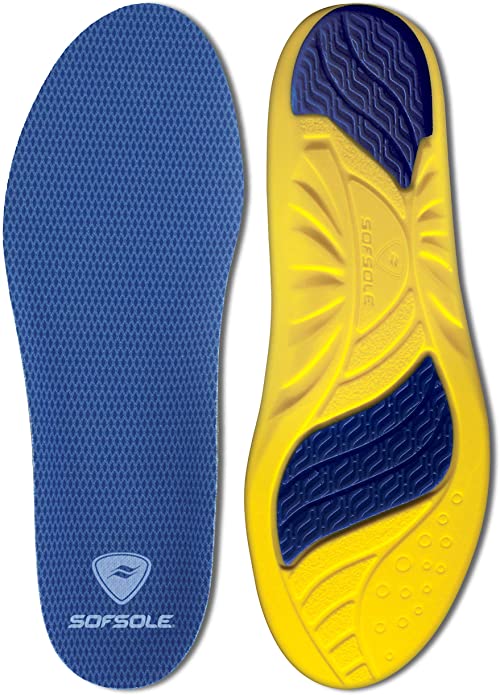
Editor’s Rating:
Quick Facts:
- Best for neutral arches
- Material: Foam with gel pad
- Trim-to-fit: Yes
The second Sof Sole product on the list, these insoles are designed to support neutral arches, unlike the FIT support insoles.
Another difference is that these insoles aren’t unisex – you can buy either the male version (featured here), or the female version – they both meet the same specifications but have a slightly different shape.
However, some features will sound familiar, like the moisture-wicking technology to manage dampness and temperature.
Insole Design
As these insoles are for people with neutral arches, they’re lightweight and feature minimal padding compared to the other Sof Sole insoles. But, because they’re so thin, they’re best for more casual soccer players rather than people who train for hours a day—anyone looking for a more heavy-duty insole might need something like the Superfeet Black Insoles.
However, there’s still some cushioning. The entire insoles are made from Implus foam to give your foot a soft landing pad, and there are gel pads in the heel and forefoot areas.
- Moisture-wicking technology to keep feet dry and cool
- Gel pads and foam provide support and comfort
- Lightweight
- Not suitable for low or high arches
- Could be uncomfortable for those who train very frequently.
10. Thinnest Soccer Insoles: Physix Gear Orthotic Inserts
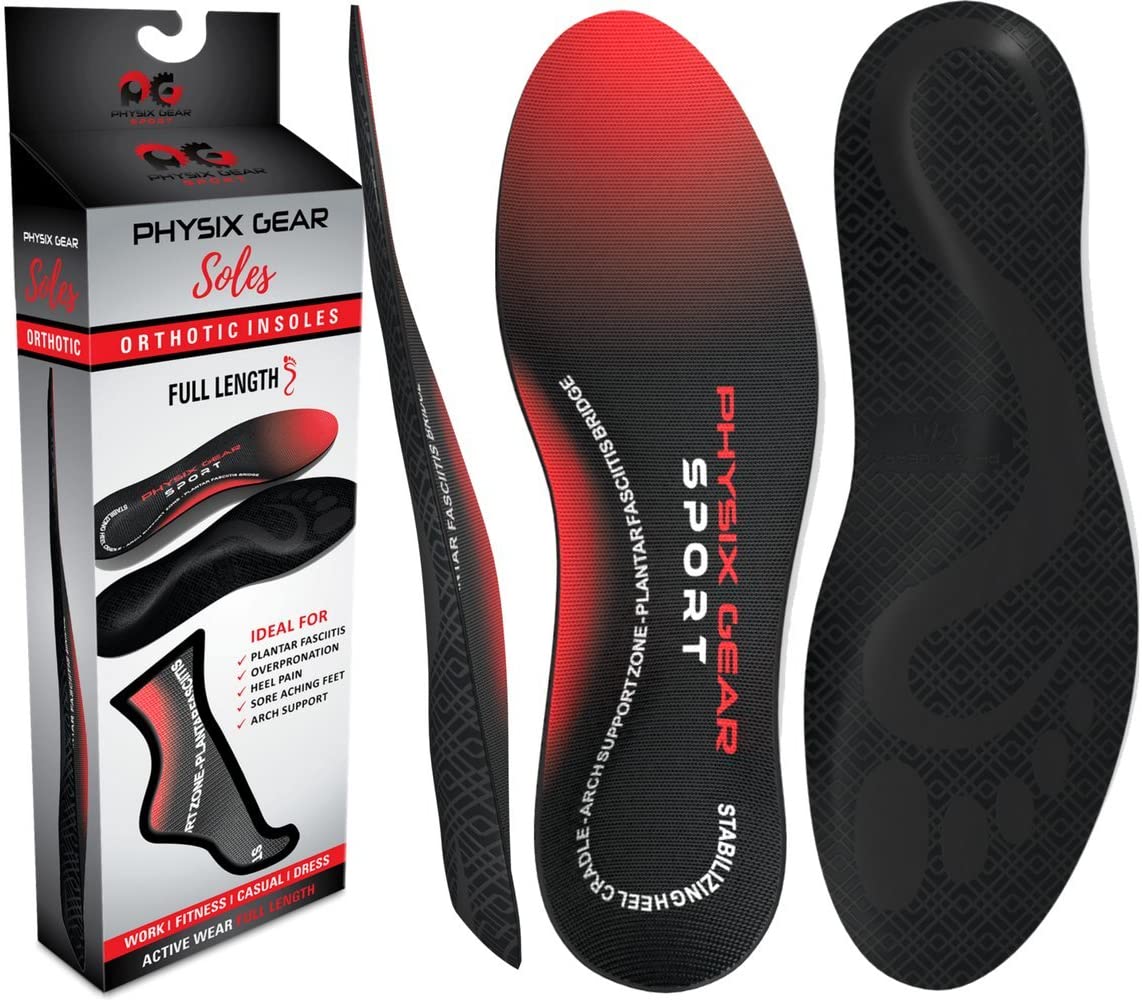
Editor’s Rating:
Quick Facts:
- Best for neutral arches
- Material: Antimicrobial foam and PU
- Trim-to-fit: Yes
If you’re concerned about buying insoles that take up too much room in your soccer cleats, going for a low-profile option like these Physix Gear insoles is ideal. They’re as thin as can be without compromising on comfort.
The insoles are crafted using medical-grade EVA foam and PU material, creating a dual-layer effect to support the foot and offer shock absorption. Meanwhile, the antimicrobial lining controls odor.
Insole Design
If you’re concerned about buying insoles that take up too much room in your soccer cleats, going for a low-profile option like these Physix Gear insoles is ideal. They’re as thin as can be without compromising on comfort.
The insoles are crafted using medical-grade EVA foam and PU material, creating a dual-layer effect to support the foot and offer shock absorption. Meanwhile, the antimicrobial lining controls odor.
- Low-profile design makes them easier to fit into soccer cleats
- Heel cradle for support
- Non-slip feature
- Insufficient support for some feet
- Too wide for some cleats
Choosing the Perfect Insoles
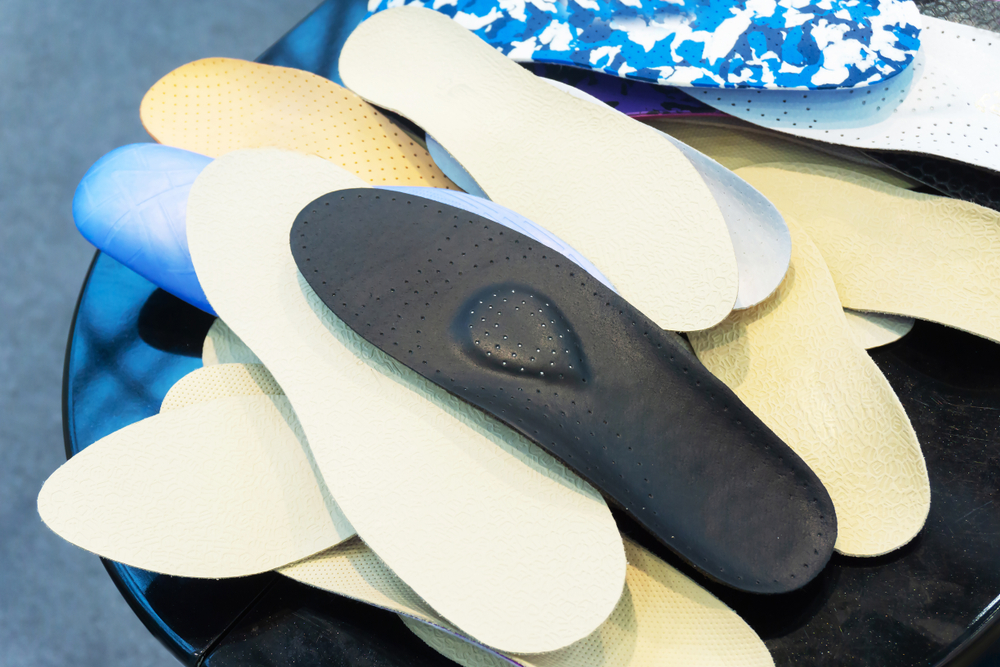
To find the best pair of soccer cleat insoles for you, you need to know every last detail about your feet – and, in some cases, the rest of your body too.
Here’s everything you ever wondered about finding the right pair of shoes, and everything you never knew that you needed to know. After you’ve finished reading, you’ll never look at your feet in the same way again!
What Type of Arches Do You Have?
One of the most important factors to consider when comparing insoles is the type of arches you have. When your foot makes contact with the ground, the whole foot doesn’t actually touch it (unless you have flat feet). Instead, a tiny arch forms between the heel and the forefront area by the toes.
You can have either low/flat arches, normal arches, or high arches.
To find out which one you have, the easiest method is to check your footprint. By dipping your foot in water (or paint) and pressing it onto paper, you can examine its shape.
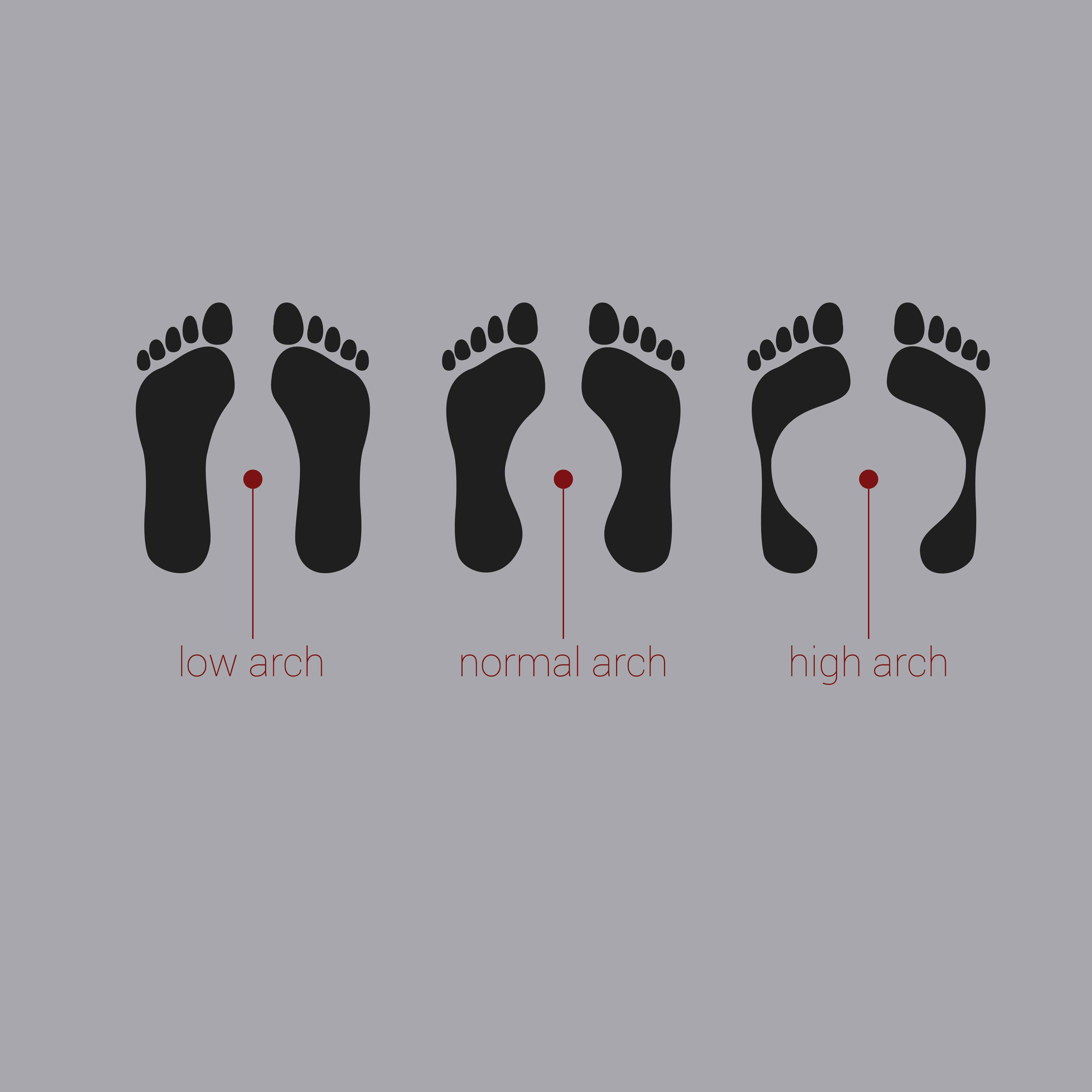
Basically, the more curved and narrow the middle of the foot is, the higher your arches are. If you have high arches, you’ll only be able to see your heel and toes on the footprint, while people with flat arches will see their entire foot shape, and those with normal arches are somewhere in between.
Low Arches
People with low arches (sometimes called flat arches) often have a tough time. When you walk or run around, your foot rolls in and could cause you all kinds of health issues. Muscle stress is common.
Look for insoles that can raise your arch and provide you extra support, like the Sof Sole support insoles.
High Arches
At the other end of the spectrum, we have high arches. But even though we need arches to keep our feet in the right position, it’s possible to have too much of a good thing. High arches can also cause health problems as they prevent proper shock absorption.
This is bad news for soccer players, who are frequently jumping and running around the pitch, subjecting their feet to high impact. Look for soles offering maximum support and cushioning, like the EASYFEET support insoles.
Normal Arches
If you have normal arches, consider yourself lucky – you’ll probably have an easier time than those with high or low arches. Your feet should naturally absorb the shock they encounter when playing soccer.
However, that doesn’t mean you don’t need insoles, it just means you don’t need excessive support. Look for something relatively firm. The Powerstep insoles could be a good option.
How to Use Insoles for the First Time
If you’ve suffered from pain or discomfort while playing soccer and you suddenly graduate to supportive insoles, you might expect instant pain relief. Unfortunately, it’s not always that simple.
When your feet aren’t used to the sensation of an insole, it might take them a while to adjust. Kind of like our digestive systems when we suddenly eat vegetables after a two-week hiatus.
Instead of making a complete switch, start by only wearing your insoles for up to three hours per day until you get used to them. That should be more than enough for soccer practice anyway, unless you’re a professional.
The Best Foams and Materials
If you want to get the most durable, high-quality insoles possible, you need to make sure you pick the right material.
A lot of insoles use a polyurethane coating, known as PU. Polyurethane adds strength and protection to insoles, making them more resistant and lightweight. However, it’s a fairly cheap and low-quality material. It’s also made from petroleum residue, which has negative environmental impact.
While PU serves its purpose, a better alternative is TPU, or thermoplastic polyurethane. Although TPU is more expensive, it’s stronger and has a higher quality than PU. An example of an insole with TPU cushioning is EASYFEET insoles.
Alternatively, ethylene-vinyl acetate (EVA) is a closed-cell foam, which makes it more firm and rigid than open-cell foams like PU. It’s ideally suited to exercise for those who don’t need extreme cushioning. For instance, Powerstep insoles use EVA.
Some insoles also use an antimicrobial coating. Silpure is a common option, which uses the properties of silver to protect fabrics from bacteria and odor. It’s used in Spenco insoles. A slightly more unusual alternative for fighting bacteria is bamboo, which is more natural but equally effective.
Choosing the Right Insoles for Your Feet
As if having high or low arches wasn’t enough to navigate, some people also have feet conditions that they need to care for.
Here’s a breakdown of some of the most common and which insoles to choose for them.
Plantar Fasciitis
In the US, around 3 million people suffer from plantar fasciitis every year – also known as policeman’s foot. It’s among the most common causes of pain in the heel and can lead to pain all across the bottom of the foot.
If you often feel a stabbing pain when you first wake up and start walking, it may be because of plantar fasciitis, although it’s more common in runners than soccer players. We recommend the Powerstep orthotic shoe insoles because of their facilitating design.
Corns
Corns are areas of thick skin that often appear on the feet of athletes – they’re similar to calluses but smaller and harder. These might sound innocent enough, but they can cause pain and irritation.
Why grin through the pain when you could alleviate it?
Try a product like EASYFEET insoles EASYFEET support insoles, which reduce the likelihood of corns by promoting breathability and support.
Heel Spur
When a calcium deposit (bone growth) builds up between the arch and heel, it results in a painful condition called heel spur. If left untreated, heel spur can spread across the foot and even up the leg. Putting too much pressure on the feet without enough support and shock absorption can be contributing factors to this condition.
Unlike plantar fasciitis and corns, you’ll need treatment to get rid of heel spur – if you suspect that you have it, time to call a doctor. Although an insole alone can’t cure the condition, they do form part of the solution. Once again, the EASYFEET support insoles are a good option to look after your feet.
Soccer Insole FAQs
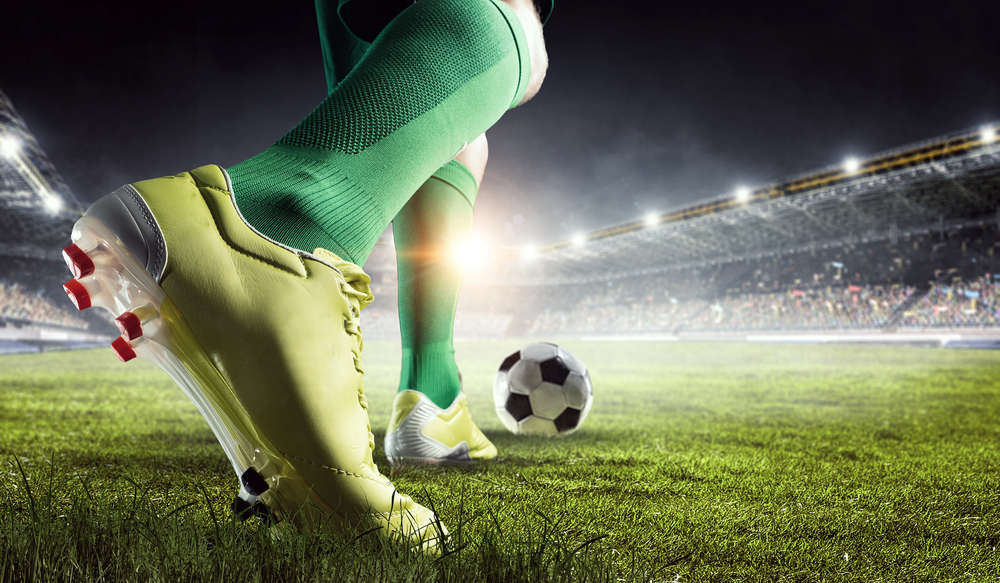
We try to be as comprehensive as possible, but there’s always something missing. In case we’ve raised more queries than we’ve answered, keep reading.
Why Do You Need Insoles for Soccer Cleats?
Out of all the activities that put pressure on your feet, few things can top soccer. To soothe your pain in the short run and prevent injury in the long run, getting a good pair of insoles is one of the best things you can do. This will also improve your performance on the field –discomfort will slow you down and distract you from playing.
Can You Put Gel Insoles in Soccer Cleats?
Gel insoles are some of the best and most supportive types of inserts for soccer cleats. The gel helps to absorb shocks and provide cushioning, protecting the foot around the heel and forefoot area. As long as the gel insoles are the right fit for your feet and soccer cleats, you can certainly use them.
How Do I Insert Insoles in My Soccer Cleats?
Most soccer cleats already have some thin and unsupportive insoles inside them; you need to remove these first. Then, see if your insoles are a perfect fit for your cleats or if you need to amend them – it’s common for insoles to be cut-to-fit, so you can trim them if they’re too wide for your shoe. Finally, place them in carefully, making sure they’re not too lose.
How Can I Choose the Right Soccer Cleats?
The most important thing to consider is the needs of your feet and shoes. If you have any health conditions (like plantar fasciitis) or high or low arches, you need to cater to that. You should also consider how wide or narrow your soccer cleats themselves are. However, other principles apply to all types of feet and shoes – always buy insoles with the best quality possible if you can afford to, as some materials are more comfortable and durable than others.
Bottom Line
By now, you should know the score when it comes to insoles for soccer cleats. There’s nothing left but to take your winning shot. See what we did there?
If you take anything away from this article, let it be that your feet are just as special as you are, and you need to cater to their individual needs. After all, where would you be without them?
